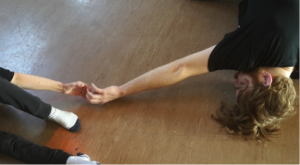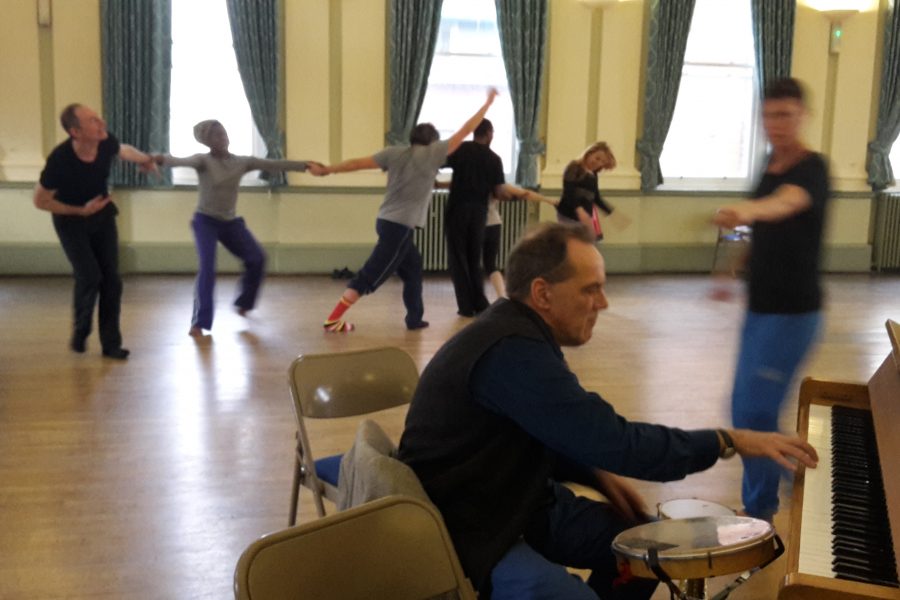An ethnographic look into Ambient Jam’s sound world by Ryan Evans
“There is a question we are entitled to ask in front of any aesthetic production: Does this work permit me to enter dialogue? Could I exist, and how, in the space it defines?”1
For six months, I practised as a musician and dancer with Ambient Jam, a movement and sound improvisation ensemble comprised of disabled and non-disabled artists. The ensemble is a nonverbal creative think-tank, stretching common conceptions of art, knowledge, and communication.2 In this radical pursuit, Ambient Jam has met weekly for more than 25 years to explore collective expression among their disabled and non-disabled ensemble members.

Ryan Evans and another ensemble member during an Ambient Jam session at Ladywell Centre, London. Photo: Rebecca Swift
I approached my time with Ambient Jam as an arts ethnographer. As a discipline, ethnography is concerned with participation in everyday life; this is because a lot of knowledge is nonverbal.3 Put another way, it can be more productive for a learner to participate in something rather than ask about it—and so I did both.4 I played music with the ensemble and had conversations with Ambient Jam’s musicians. In doing so, I turned my ethnographic attention to the ensemble’s sonic practice—the set of techniques that cultivate Ambient Jam’s “sound world.”
Most of Ambient Jam’s musicians were resistant to putting such a nonverbal practice into words. This reaction is understandable. Many ensemble members are nonverbal, so talking and writing about Ambient Jam like this could equate to an act of exclusion. As Eli Clare so clearly summarized, “Disability oppression is about access.”5 And so I struggle somewhat writing this piece, knowing that it is inaccessible to some ensemble members. At the same time, I believe in the reflective process of documenting Ambient Jam’s sonic practice. Recognising the limits of written language, I also audio recorded some sessions; snippets from these recordings are presented later in this piece and represent another mode of documenting the ensemble’s sound.
The sound of Ambient Jam is well-captured by a quote from pivotal improviser John Stevens: “All sound is rhythmelodic. Put any pulse underneath the apparently random rhythms of birdsong or conversation and it will fit.”6 This idea of “anything is music” offers a useful starting point for understanding Ambient Jam’s sonic practice. Another useful starting point is the idea of “musicking,” which stresses that the roles of “musician” and “listener” are equally important for the act of making music.7 During Ambient Jam sessions, the musician does not hold sole responsibility for the session’s sound—this responsibility is shared by everyone present, regardless of whether they call themselves a musician.
These flexible definitions of music are foundational to Ambient Jam’s sonic practice—in part because some ensemble members are deaf or hard of hearing. And so the question at the beginning of this piece takes on renewed meaning: “Does this work permit me to enter dialogue? Could I exist, and how, in the space it defines?” Ambient Jam’s sonic practice represents an alternative kind of music—one that is explicitly inclusive of people who are hearing-impaired. My goal in writing this piece is to try and communicate the techniques of this alternative, exploratory musical genre.
Ambient Jam’s sonic practice
In my time with Ambient Jam, I came to think of the ensemble’s sonic practice as rooted in three main techniques:
- Listening-Observing
- Responding-Offering
- Holding-Encouraging
I chose to describe these techniques as pairs of words to honour the complex ways that Ambient Jam musicians talked about them—and, as Roger Sanjek calls out, to highlight “the conscious and unconscious decisions that ethnographers make about what to observe, hear, and write down.”8 By complexifying how I represent these techniques, I hope to draw attention to what multiple Ambient Jam musicians told me: “There is no one way.” Undoubtedly, there are other—equally valid—ways of making sense of Ambient Jam’s sound world.
Listening-Observing
“I sometimes just stop and wait—listening, watching, observing.”
-Ambient Jam musician
Listening-observing refers to Ambient Jam musicians listening to and observing fellow ensemble members—and making music based on what they hear and see. During sessions, musicians said they intently listen to the sounds that ensemble members make with their voices, bodies, and objects in the room. Musicians also talked about the importance of observing body language and spatial relationships, such as the looks on ensemble members’ faces, who is interacting with whom, the ensemble’s energy level, how ensemble members move in the room, and so on. As one musician said, “You’re just listening all the time.” The information that musicians glean from listening-observing guides the music they make during sessions.
Example of “listening-observing”
In this recording, you can hear the musician gradually quieting their drum, dropping in volume so that their sound is barely perceptible. This decrease in volume showcases the sounds that other ensemble members are making during the session—in this case, mainly vocal sounds. Listen to what you can hear as the drum quiets down.
Responding-Offering
“It’s about what you do with what you hear in the room.”
-Ambient Jam musician
Responding-offering refers to when Ambient Jam musicians play, sing, or otherwise make sound in response to what they hear and observe. I decided to call this technique “responding-offering” because each response also represents a musical offering. Musicians talked about responding-offering as a continuously reflective practice—while playing, they reflect on what they’re playing and why they’re playing it. As one musician said, “It is not self-expression. I’m reflecting the whole time.” This is an important point about how these techniques are inter-related—when responding-offering, musicians are also listening-observing, and they alter what they play based on what they hear and see.
Example of “responding-offering”
At the beginning of this recording, you can hear the vocal responses and offerings of many ensemble members. This is an example of the entire ensemble sharing responsibility for the session’s sound. About 60 seconds into the recording, you can hear a musician offer a melody line on the flute. Listen to how this offering responds to the vocal sounds that preceded it as well as to how the ensemble then responds to the flute.
Holding-Encouraging
“I keep a rhythm, reliable and consistent, certain—like a foundation. So that other things can play on top of it.” -Ambient Jam musician
Holding-encouraging refers to repeating or sustaining the same phrase, pulse, note, or other kind of musical idea. Ambient Jam musicians said that this was a way of “holding” the multitude of sounds and rhythms in the session. This concept is similar to the John Stevens quote from earlier in this piece—“Put any pulse underneath the apparently random rhythms of birdsong or conversation and it will fit.” Ambient Jam musicians also explained how repeating or sustaining a musical idea often encourages other ensemble members to sonically expand on that idea—and so the technique became known as “holding-encouraging.”
Example of “holding-encouraging”
At the beginning of this recording, you can hear a repeated, sustained drum pattern. About 60 seconds into the recording, you can hear another ensemble member respond with their own percussive offering. Then, for about 5 minutes, you can hear how the “holding” of this pulse on the drum encourages the ensemble to explore a variety of percussive sounds and patterns using objects in the room (chairs and other drums) and their bodies (claps and stomps). Listen for when the drum is responding to other sounds in the room—and for when the other sounds in the room respond to the drum.
The interplay of these techniques: Ambient Jam’s sound world
During Ambient Jam sessions, these techniques are not so distinguishable from each other. They coalesce, meld, blend, and overlap to create Ambient Jam’s sound world. Ethnographers are well-acquainted with the challenges of trying to explain complex, nonverbal phenomena like this.9 Despite its limitations—and perhaps because of them—I hope that this ethnographic look at Ambient Jam’s sound world is useful for the ensemble as they explore at the boundaries of music, sound, expression, and communication.
Ryan Evans is a community artist and arts consultant. Currently based in London, he is pursuing a master’s degree in Applied Anthropology and Community Arts—and will return home to Minnesota after finishing his studies. As a consultant with Wilder Research, Ryan designs and facilitates learning projects for arts organizations. As a community artist, he leads participatory music and movement sessions with intergenerational and mixed ability groups. He released his debut ambient tape in early 2019.
_________________
References
1 Bourriaud, N. (1998) Relational Aesthetics. Paris: Les Presses Du Reel.
2 Crehan, K. (2013) Community Art: An Anthropological Perspective. New York: Bloomsbury.
3 Jenkins, T. (1994) Fieldwork and the Perception of Everyday Life. Man, New Series, 29(2), 433-455. London: Royal Anthropological Institute.
4 Walmsley, B. (2014) Deeping Hanging Out in the Arts: An Anthropological Approach to Capturing Cultural Value. International Journal of Cultural Policy, 24(2), 272-291.
5 Kuppers, P. (2014) Studying Disability Arts and Culture: An Introduction. New York: Palgrave Macmillan.
6 Stevens, J. (2007) Search & Reflect: A Music Workshop Handbook. Teddington: Rockschool.
7 Small, C. (1998) Musicking: The Meanings of Performing and Listening. Middletown: Wesleyan University Press.
8 Sanjek, R. (1990) Fieldnotes: The Makings of Anthropology. Ithica: Cornell University Press.
9 Hammersley, M. (1991) What’s Wrong with Ethnography. London: Routledge.


